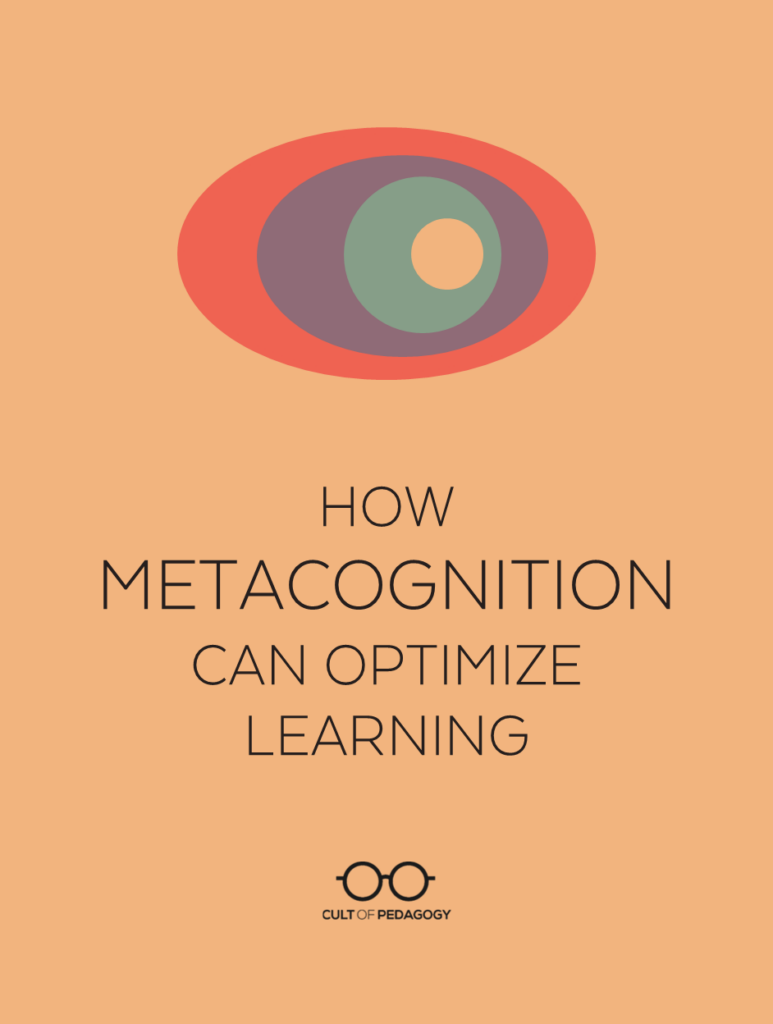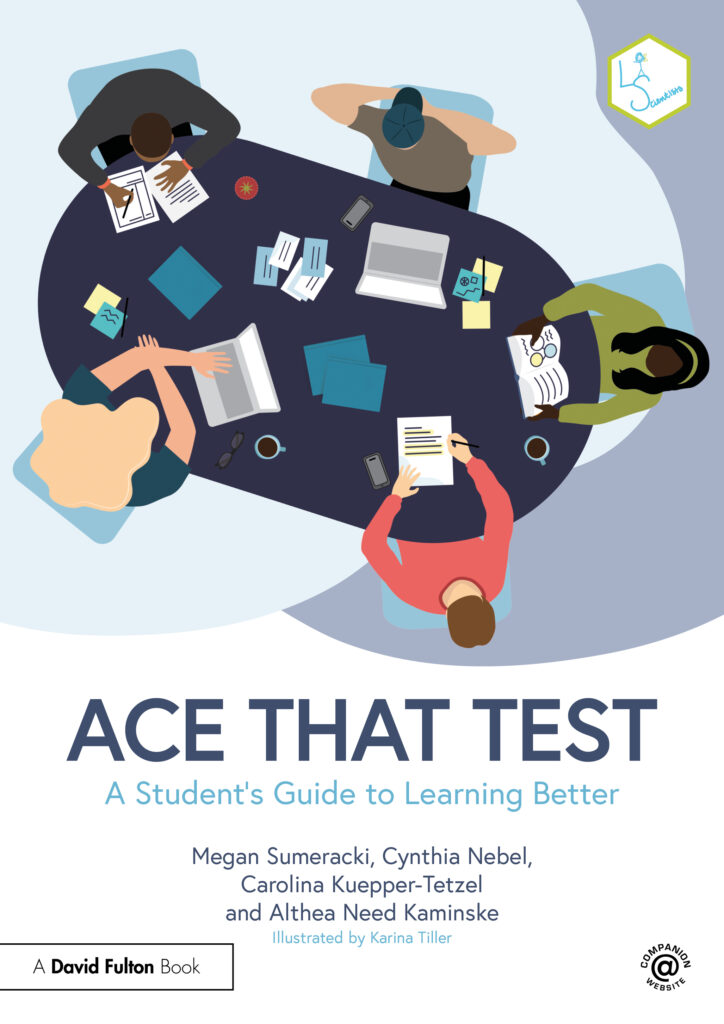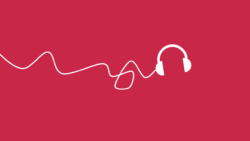
Listen to my interview with Megan Sumeracki (transcript):
Sponsored by EVERFI and The Wired Classroom
This page contains Bookshop.org links. When you make a purchase through these links, Cult of Pedagogy gets a small percentage of the sale at no extra cost to you. What’s the difference between Amazon and Bookshop.org?
Here’s a scenario you might be familiar with: A person — maybe you, maybe someone you know — studies for hours to prepare for a test. Hours. Days, even. And then when test day comes they completely blow it. “I don’t understand,” they say. “I studied so hard. I thought I knew that stuff.”
The act of thinking about our own thinking, of knowing what we know and don’t know, is referred to in academic circles as metacognition, and it plays a huge role in how well our brain holds on to information. If we can get a better understanding of how metacognition works, we can tap into it to improve our learning and teach our students to do the same.
Helping us do that is Megan Sumeracki, a professor of cognitive psychology at Rhode Island College. Her area of expertise is human learning and memory, and applying the science of learning in educational contexts.

In 2023, she co-wrote a book called Ace That Test: A Student’s Guide to Learning Better, which offers evidence-based learning strategies students can use to study more effectively. On the podcast, we talked about what metacognition is, what it looks like when our metacognitive monitors are wonky, and how learners can leverage it to optimize learning — and stop putting in the wrong kinds of effort when studying. You can listen to the interview in the player above or read the full transcript here. Below are some highlights from our conversation.
What Exactly Is Metacognition?
“In the context of learning and education,” Sumeracki says, “it’s knowing what you know and also knowing what you don’t know.”
She explains that we can break the larger concept into two parts:
- Metacognitive monitoring, or metacognitive awareness, is our own assessment of what we know.
- Metacognitive control, or metacognitive action, is the decisions we make based on our monitoring.
“If we can assess and become aware of what we know and don’t know,” Sumeracki says, “and then use that to drive the decisions we make about learning — whether that is studying more or studying differently or waiting a little bit and studying later, whatever the case may be — these two things should work really well together.”
“The problem is that our monitoring is not always accurate,” she says. “It’s not like we can just sort of open our heads, take a look, and see: Is the information there or isn’t it? If we ask a group of students, how well do you think you understand this? Are we good? Can we move on? Their responses may or may not be accurate. And so the way to optimize in education is to focus on the ways that we can help our students monitor in a more accurate way. The more accurate they are, the better those control decisions will be.”
When Metacognition Is Off
One place we commonly see inaccurate monitoring is when students study by repeatedly reading material, giving themselves the false impression that they know the information well as a result.
“When you are re-reading something,” Sumeracki explains, “the first time through it might not make as much sense. It might be difficult. There might be words you don’t understand or it’s just not going to be as solid as the second time you read it. The second time you read it, it’s a little bit more fluent, it’s a bit more familiar. It feels like you know it better, and so as you’re reading and re-reading and re-reading, each time it becomes more fluent and familiar, you get this sense of, Wow, I really know this. I really understand it. I’m going to remember it.”
That confidence, she says, is false. “When there’s a little bit of time, and then we take that reading away, it’s very difficult for the students to describe and explain what they just read, especially a few days or weeks later. Their metacognitive monitoring is too high. They’re overconfident. They think they know and will remember things that they don’t. And then when it comes time to take a test or they need to use the information, they’re not going to remember it as well.”
A more effective way to fine-tune metacognitive monitoring is by studying with retrieval practice, the process of trying to retrieve information from memory without having the information in front of you. It can be done in many ways: using flashcards, explaining a concept in your own words, taking a quiz, or just getting a sheet of paper and writing down everything you remember about a concept. Because learning through retrieval practice is more difficult, it gives us a more accurate picture of how well we have learned something.
“When you practice retrieval,” Sumeracki says, “it is difficult in the moment. You read something or you’ve learned about something, and then you put it aside, and you have to try to produce it on your own. It’s a difficult task. It does not feel familiar or fluent.” This difficulty makes students slightly underconfident about their mastery of the material — the exact opposite of what re-reading does — and therefore prompts them to keep studying, keep trying to retrieve, which helps them learn more effectively.
How to Help Students Fine-Tune Their Metacognition
Here are some moves teachers can make to help students develop more accurate metacognitive monitoring:
1. Do Retrieval Practice
On a regular basis, give students opportunities to practice retrieval, where they put their materials away and try to explain concepts in their own words — not just bringing it to mind, but actually producing something, whether it be spoken, in writing, or sketched out in some way. Sumeracki points out that this is an important difference: Simply thinking the concepts can give us a false sense of really knowing them, whereas it’s much harder to reproduce the information ourselves. “You definitely want them to produce it explicitly because that forces them to really figure out: Can I put this in my own words?”
2. Hold Metacognitive Check-ins
When you do these retrieval practice sessions, set aside an extra minute afterward to ask students to rate their understanding of the content, maybe on a scale of one to ten. Even better, have them do this rating right before and then right after doing retrieval. This further calibrates their metacognitive monitoring: A student who overestimates their understanding of a concept, then discovers through retrieval practice that they don’t know it as well as they thought will be more likely to spend more time studying that concept afterward.
3. Space the Learning
It’s not hard to remember something you learned five minutes ago, but yesterday? Last week? That’s where it becomes a lot harder, so if we space out retrieval with students, they are more likely to have forgotten some things, and this will make their assessment of their own understanding — their metacognitive monitoring — much more accurate. “So if you give a lesson on a Monday,” Sumeracki says, “and then you’ve got them on Tuesday, at the beginning of class on Tuesday, okay, can we try to retrieve what we talked about yesterday? Or maybe it’s been two days or a week. How well do we know it? There is some forgetting over time. That’s okay — it’s making our metacognitive monitoring more accurate and more grounded into what we actually know.”
4. Build Awareness of Metacognitive Pitfalls
Educate students on the research about our tendency to be overconfident after reading and re-reading. Sumeracki advises “helping them make their own study decisions based on knowing that repeated reading and highlighting might help at some point, but that it’s not the only choice and it’s not always the best choice. And just sort of normalizing that learning is hard and it’s okay. It’s not a failure if you know you don’t know something. You’re not going to get it immediately. It is going to take more practice.”
You can find more of Megan Sumeracki’s work at learningscientists.org.
Join our mailing list and get weekly tips, tools, and inspiration that will make your teaching more effective and fun. You’ll get access to our members-only library of free downloads, including 20 Ways to Cut Your Grading Time in Half, the e-booklet that has helped thousands of teachers save time on grading. Over 50,000 teachers have already joined—come on in.






As always, love these posts! To the metacognitive check-ins, I like to break the self-assessment into two parts: content (what do you know) and process (who were you along the way/what did you put in place along the way to build and hold yourself accountable around attentiveness, flexibility, effective effort, etc – whatever the agreed upon individual goal or group-determined goal is). Such good stuff in these posts always – thanks for the ideas and opportunity to think about this. Super important!
We’re glad you found the post valuable! Thanks so much for sharing!